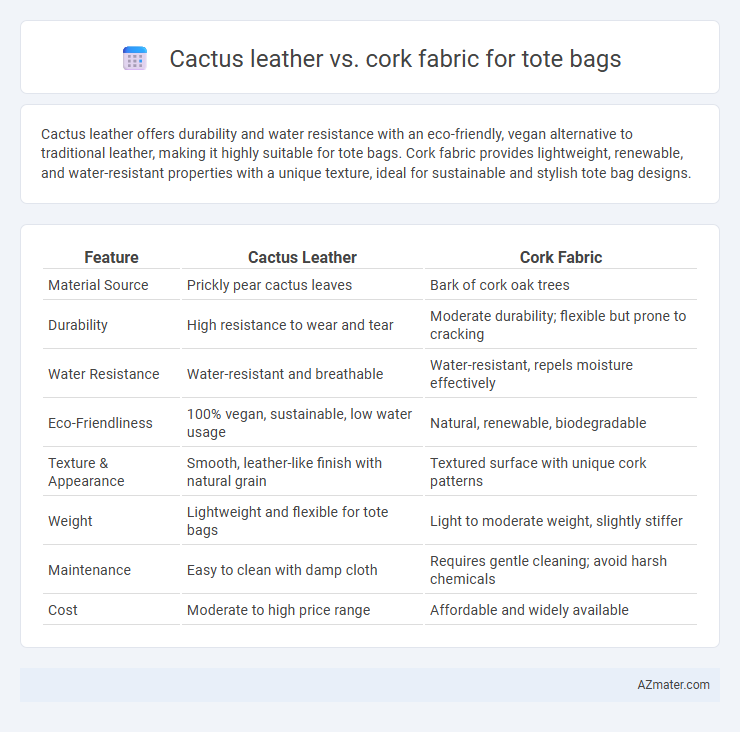Cactus leather offers durability and water resistance with an eco-friendly, vegan alternative to traditional leather, making it highly suitable for tote bags. Cork fabric provides lightweight, renewable, and water-resistant properties with a unique texture, ideal for sustainable and stylish tote bag designs.
Table of Comparison
| Feature | Cactus Leather | Cork Fabric |
|---|---|---|
| Material Source | Prickly pear cactus leaves | Bark of cork oak trees |
| Durability | High resistance to wear and tear | Moderate durability; flexible but prone to cracking |
| Water Resistance | Water-resistant and breathable | Water-resistant, repels moisture effectively |
| Eco-Friendliness | 100% vegan, sustainable, low water usage | Natural, renewable, biodegradable |
| Texture & Appearance | Smooth, leather-like finish with natural grain | Textured surface with unique cork patterns |
| Weight | Lightweight and flexible for tote bags | Light to moderate weight, slightly stiffer |
| Maintenance | Easy to clean with damp cloth | Requires gentle cleaning; avoid harsh chemicals |
| Cost | Moderate to high price range | Affordable and widely available |
Introduction to Eco-Friendly Tote Bag Materials
Cactus leather and cork fabric represent innovative, sustainable alternatives to traditional leather for tote bags, offering durability and eco-conscious appeal. Cactus leather, derived from mature cactus leaves, provides a cruelty-free, biodegradable option with a soft, supple texture resembling genuine leather. Cork fabric, harvested from the bark of cork oak trees without tree cutting, features water resistance, lightweight strength, and a unique natural grain, making it ideal for environmentally friendly tote bags.
What is Cactus Leather?
Cactus leather is an innovative, sustainable material made from mature nopal cactus leaves, offering a vegan alternative to traditional leather with a natural texture and durability. It requires minimal water and pesticides during cultivation, significantly reducing environmental impact compared to animal leather and synthetic alternatives. Ideal for tote bags, cactus leather combines eco-friendly practices with a soft, pliable feel and strong resistance to wear and tear.
Understanding Cork Fabric
Cork fabric, derived from the bark of cork oak trees, offers a sustainable and eco-friendly alternative to traditional leather for tote bags. Its natural water resistance, durability, and unique texture make it ideal for lightweight, resilient accessories while providing a hypoallergenic and biodegradable option. Compared to cactus leather, cork fabric typically requires less water and chemical processing, enhancing its environmental benefits.
Sustainability: Cactus Leather vs Cork Fabric
Cactus leather and cork fabric both offer sustainable alternatives to traditional leather, with cactus leather derived from mature cactus leaves requiring minimal water and pesticides, highlighting its eco-friendly cultivation. Cork fabric is harvested from the bark of cork oak trees without harming the tree, enabling repeated harvests every nine years and promoting forest conservation. Both materials contribute to reducing environmental impact, though cactus leather's lower water usage and faster growth cycle provide a notable advantage in sustainability metrics for tote bag production.
Durability and Longevity Comparison
Cactus leather offers high durability with its natural elasticity and resistance to cracking, making it suitable for tote bags exposed to frequent use and varying weather conditions. Cork fabric provides excellent longevity due to its water-resistant and antimicrobial properties, maintaining integrity even after prolonged wear. Both materials outperform traditional leather in sustainability, but cactus leather tends to show greater resilience under mechanical stress, while cork excels in moisture resistance.
Aesthetic Appeal and Design Options
Cactus leather offers a sleek, smooth finish with a subtle natural grain, lending a modern and sophisticated aesthetic to tote bags, while cork fabric presents a unique, textured surface with organic patterns that emphasize eco-friendly design. Design options with cactus leather often include vibrant dyeing possibilities and a polished look, whereas cork fabric allows for eco-conscious customization with its matte tones and natural variations. Both materials cater to different visual preferences, with cactus leather aligning with minimalist elegance and cork fabric appealing to rustic, earthy styles.
Water Resistance and Maintenance
Cactus leather offers moderate water resistance due to its dense fibrous structure, allowing tote bags to withstand light splashes without immediate damage. Cork fabric excels in water resistance, with its natural waxy coating repelling moisture effectively and preventing absorption, ensuring tote bags remain dry in wet conditions. Maintenance for cactus leather involves gentle cleaning with a damp cloth and avoiding prolonged exposure to water, while cork fabric is easily cleaned with mild soap and water, requiring less frequent treatment to maintain its waterproof properties.
Pricing and Market Availability
Cactus leather typically commands higher prices due to its labor-intensive production and limited supply compared to cork fabric, which is more affordable and widely available. Cork fabric benefits from sustainable harvesting practices and established market channels, making it a cost-effective option for tote bags. Consumers seeking luxury or vegan alternatives may prefer cactus leather despite its premium cost, whereas cork fabric appeals to budget-conscious buyers with eco-friendly preferences.
Ethical and Environmental Impact
Cactus leather offers a sustainable alternative to animal leather by using minimally processed mature cactus leaves, reducing water consumption and carbon emissions compared to traditional leather production. Cork fabric, harvested from the bark of cork oak trees without harming them, supports biodiversity and promotes reforestation efforts, making it a renewable and biodegradable material. Both materials are vegan-friendly and biodegradable, with cactus leather generally requiring less energy-intensive processing, while cork's natural durability enhances product longevity, contributing to lower environmental impact overall.
Choosing the Best Material for Your Tote Bag
Cactus leather offers a sustainable, cruelty-free alternative with a soft, durable texture and water-resistant properties ideal for tote bags, ensuring long-lasting use and eco-friendly appeal. Cork fabric features natural waterproofing, lightweight strength, and hypoallergenic qualities, making it excellent for environmentally conscious consumers seeking a unique, vegan option. Choosing between cactus leather and cork fabric depends on your preference for texture and durability versus the need for ultra-lightweight and natural water resistance in your tote bag.

Infographic: Cactus leather vs Cork fabric for Tote bag
 azmater.com
azmater.com